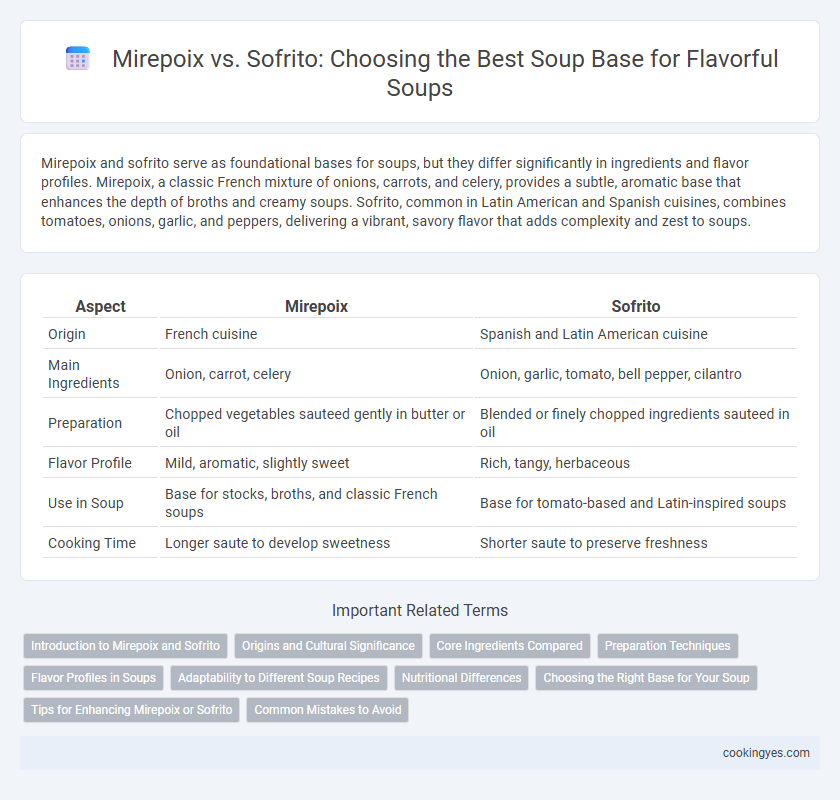Mirepoix and sofrito serve as foundational bases for soups, but they differ significantly in ingredients and flavor profiles. Mirepoix, a classic French mixture of onions, carrots, and celery, provides a subtle, aromatic base that enhances the depth of broths and creamy soups. Sofrito, common in Latin American and Spanish cuisines, combines tomatoes, onions, garlic, and peppers, delivering a vibrant, savory flavor that adds complexity and zest to soups.
Table of Comparison
| Aspect | Mirepoix | Sofrito |
|---|---|---|
| Origin | French cuisine | Spanish and Latin American cuisine |
| Main Ingredients | Onion, carrot, celery | Onion, garlic, tomato, bell pepper, cilantro |
| Preparation | Chopped vegetables sauteed gently in butter or oil | Blended or finely chopped ingredients sauteed in oil |
| Flavor Profile | Mild, aromatic, slightly sweet | Rich, tangy, herbaceous |
| Use in Soup | Base for stocks, broths, and classic French soups | Base for tomato-based and Latin-inspired soups |
| Cooking Time | Longer saute to develop sweetness | Shorter saute to preserve freshness |
Introduction to Mirepoix and Sofrito
Mirepoix is a classic French soup base consisting of diced onions, carrots, and celery, providing a delicate and aromatic foundation for stocks and broths. Sofrito, commonly used in Spanish and Latin American cuisines, combines sauteed onions, garlic, tomatoes, and peppers to deliver a rich, flavorful base with a slightly robust and tangy profile. Both mirepoix and sofrito serve as essential flavor-building blocks but differ in ingredient composition and cultural culinary applications.
Origins and Cultural Significance
Mirepoix, originating from French cuisine, traditionally combines diced onions, carrots, and celery to create a subtly aromatic soup base essential to classic European dishes. Sofrito, rooted in Spanish and Latin American culinary traditions, features a blend of sauteed tomatoes, onions, garlic, and peppers, infusing soups with rich, complex flavors reflecting its diverse cultural heritage. Both bases serve as foundational elements that highlight the unique regional ingredients and cooking techniques distinctive to their respective cultures.
Core Ingredients Compared
Mirepoix consists primarily of diced onions, carrots, and celery, creating a subtly sweet and aromatic base for soups. Sofrito typically includes tomatoes, garlic, onions, and peppers, providing a richer, more robust flavor profile infused with herbs like cilantro or bay leaves. Choosing between mirepoix and sofrito impacts the soup's overall taste and cultural character, with mirepoix offering a mild, earthy foundation and sofrito delivering a vibrant, spiced essence.
Preparation Techniques
Mirepoix consists of finely diced carrots, onions, and celery sauteed slowly in butter or oil to develop a sweet, aromatic base rich in umami flavor, commonly used in French cuisine. Sofrito combines finely chopped onions, garlic, tomatoes, and peppers sauteed in olive oil over medium heat, infusing soups with bright, bold, and savory Mediterranean or Latin American notes. The distinct preparation techniques influence the soup's foundational flavor profile, with mirepoix favoring gentle caramelization and sofrito emphasizing a vibrant, stewed vegetable mixture.
Flavor Profiles in Soups
Mirepoix combines diced onions, carrots, and celery, creating a sweet, subtle flavor that forms a balanced aromatic foundation in soups. Sofrito incorporates garlic, onions, tomatoes, and peppers, delivering a robust, bold, and slightly smoky taste that enhances hearty and spicy soups. Choosing between mirepoix and sofrito affects the soup's depth and complexity, with mirepoix offering gentle sweetness and sofrito providing vibrant, layered flavors.
Adaptability to Different Soup Recipes
Mirepoix, a classic French mixture of onions, carrots, and celery, provides a subtle, balanced flavor that adapts well to a variety of soups such as chicken noodle, vegetable, and cream-based recipes. Sofrito, with its blend of tomatoes, garlic, onions, and peppers, imparts a robust, aromatic base ideal for Latin American and Mediterranean soups like black bean soup and seafood stew. Both bases enhance soups uniquely, with mirepoix offering versatility across mild to hearty broths while sofrito delivers a vibrant, bold taste profile suited for spiced and tomato-based soups.
Nutritional Differences
Mirepoix, composed of onions, carrots, and celery, offers a rich source of vitamins A, C, and dietary fiber, supporting immune function and digestion. Sofrito, typically made with tomatoes, garlic, onions, and bell peppers, provides higher antioxidant content, including lycopene and vitamin C, which contribute to cellular health and inflammation reduction. Both bases enrich soups with essential micronutrients, but sofrito's tomato foundation generally delivers more antioxidants compared to the root vegetable profile of mirepoix.
Choosing the Right Base for Your Soup
Mirepoix, a classic French base, combines diced onions, carrots, and celery to create a subtle, sweet foundation ideal for clear broths and creamy soups. Sofrito, common in Latin American and Spanish cuisines, incorporates onions, garlic, peppers, and tomatoes, offering a robust, aromatic flavor perfect for hearty, spice-forward soups. Selecting between mirepoix and sofrito depends on the desired flavor profile, regional authenticity, and the soup's overall complexity.
Tips for Enhancing Mirepoix or Sofrito
Enhance mirepoix by finely dicing equal parts of onion, carrot, and celery for even flavor distribution and sweating the vegetables slowly over low heat to release natural sweetness without browning. For sofrito, maximize depth by using ripe tomatoes, garlic, bell peppers, and onions sauteed in olive oil until aromatic, while incorporating herbs like cilantro or oregano for a vibrant Mediterranean or Latin American flavor. Both bases benefit from deglazing the pan with broth or wine to lift caramelized bits, intensifying the soup's overall complexity.
Common Mistakes to Avoid
Using mirepoix or sofrito as a soup base requires accurate ingredient ratios to avoid overpowering flavors; mirepoix traditionally balances equal parts of celery, carrot, and onion, while sofrito emphasizes garlic, tomatoes, and peppers. A common mistake is substituting one for the other without adjusting cooking times, as mirepoix benefits from slow sauteing to develop sweetness, whereas sofrito needs quick, high-heat cooking to preserve freshness and acidity. Overcooking sofrito can result in bitterness, while undercooking mirepoix leads to a raw taste that diminishes its aromatic foundation.
Mirepoix vs Sofrito for soup base Infographic

 cookingyes.com
cookingyes.com